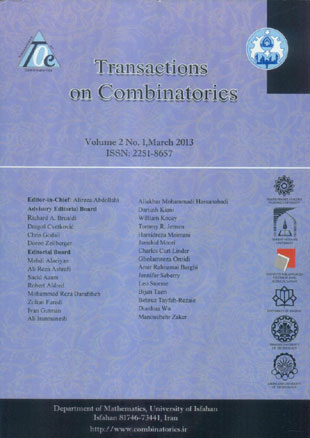فهرست مطالب

Transactions on Combinatorics
Volume:2 Issue: 1, Mar 2013
- تاریخ انتشار: 1392/01/20
- تعداد عناوین: 6
-
-
Pages 1-8In this paper, we define the common minimal common neighborhood dominating signed graph (or common minimal $CN$-dominating signed graph) of a given signed graph and offer a structural characterization of common minimal $CN$-dominating signed graphs. In the sequel, we also obtained switching equivalence characterization: $overline{Sigma} sim CMCN(Sigma)$, where $overline{Sigma}$ and $CMCN(Sigma)$ are complementary signed graph and common minimal $CN$-signed graph of $Sigma$respectively.Keywords: Signed graphs, Balance, Switching, Common minimal $CN$, dominating signed graph, Negation
-
Pages 9-16A set $S$ of vertices in a graph $G$ is a dominating set if every vertex of $V-S$ is adjacent to some vertex in $S$. The domination number $gamma(G)$ is the minimum cardinality of a dominating set in $G$. The annihilation number $a(G)$ is the largest integer $k$ such that the sum of the first $k$ terms of the non-decreasing degree sequence of $G$ is at most the number of edges in $G$. In this paper, we show that for any tree $T$ of order $nge 2$, $gamma(T)le frac{3a(T)+2}{4}$, and we characterize the trees achieving this bound.Keywords: annihilation number, dominating set, domination number
-
Pages 17-26We construct two classes of Gray maps, called type-I Gray map and type-II Gray map, for a finite $p$-group $G$. Type-I Gray maps are constructed based on the existence of a Gray map for a maximal subgroup $H$ of $G$. When $G$ is a semidirect product of two finite $p$-groups $H$ and $K$, both $H$ and $K$ admit Gray maps and the corresponding homomorphism $psi:Hlongrightarrow {rm Aut}(K)$ is compatible with the Gray map of $K$ in a sense which we will explain, we construct type-II Gray maps for $G$. Finally, we consider group codes over the dihedral group $D_8$ of order 8 given by the set of their generators, and derive a representation and an encoding procedure for such codes.Keywords: Finite group, Code, Gray map, Isometry
-
Pages 27-37For a simple digraph $G$ of order $n$ with vertex set ${v_1,v_2,ldots, v_n}$, let $d_i^+$ and $d_i^-$ denote the out-degree and in-degree of a vertex $v_i$ in $G$, respectively. Let $D^+(G)=diag(d_1^+,d_2^+,ldots,d_n^+)$ and $D^-(G)=diag(d_1^-,d_2^-,ldots,d_n^-)$. In this paper we introduce $widetilde{SL}(G)=widetilde{D}(G)-S(G)$ to be a new kind of skew Laplacian matrix of $G$, where $widetilde{D}(G)=D^+(G)-D^-(G)$ and $S(G)$ is the skew-adjacency matrix of $G$, and from which we define the skew Laplacian energy $SLE(G)$ of $G$ as the sum of the norms of all the eigenvalues of $widetilde{SL}(G)$. Some lower and upper bounds of the new skew Laplacian energy are derived and the digraphs attaining these bounds are also determined.Keywords: energy, Laplacian energy, skew energy, skew Laplacian energy, eigenvalues
-
Pages 39-101Numerous problems encountered in real life cannot be actually formulated as a single objective problem; hence the requirement of Multi-Objective Optimization (MOO) had arisen several yearsago. Due to the complexities in such type of problems powerful heuristic techniques were needed, which has been strongly satisfied by Swarm Intelligence (SI) techniques. Particle Swarm Optimization (PSO) has been established in 1995 and became a very mature and most popular domain in SI. Multi-Objective PSO (MOPSO) established in 1999, has become an emerging field for solving MOOs with a large number of extensive literature, software, variants, codes and applications. This paper reviews all the applications of MOPSO in miscellaneous areas followed by the study on MOPSO variants in our next publication. An introduction to the key concepts in MOO is followed by the main body of review containing survey of existing work, organized by application area along with their multiple objectives, variants and further categorized variants.Keywords: Multi, Objective Particle Swarm Optimization, Conflicting objectives, Particle Swarm Optimization, Pareto optimal set, Non, dominated solutions
-
Pages 103-111Let $G=(V,E)$ be a connected graph. The eccentric connectivity index of $G$, $xi^{c}(G)$, is defined as $xi^{c}(G)=sum_{vin V(G)}deg(v)ec(v)$, where $deg(v)$ is the degree of a vertex $v$ and $ec(v)$ is its eccentricity. The eccentric distance sum of $G$ is defined as $xi^{d}(G)=sum_{vin V(G)}ec(v)D(v)$, where $D(v)=sum_{uin V(G)}d_{G}(u,v)$ and $d_{G}(u,v)$ is the distance between $u$ and $v$ in $G$. In this paper, we calculate the eccentric connectivity index and eccentric distance sum of generalized hierarchical product of graphs. Moreover, we present explicit formulae for the eccentric connectivity index of $F$-sum graphs in terms of some invariants of the factors. As applications, we present exact formulae for the values of the eccentric connectivity index of some graphs of chemical interest such as $C_{4}$ nanotubes, $C_{4}$ nanotoris and hexagonal chains.Keywords: Eccentric connectivity index, eccentric distance sum, generalized hierarchical product, $F$, sum graphs

